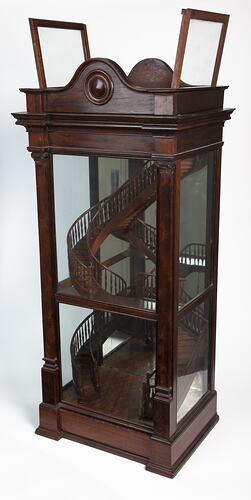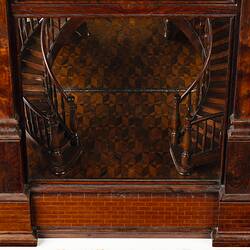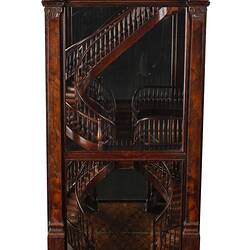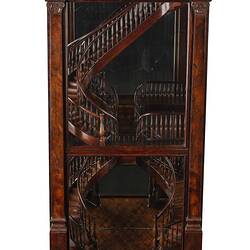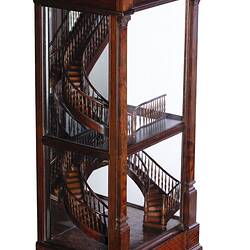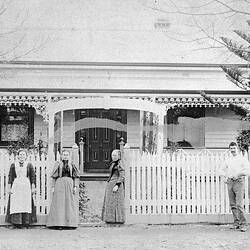Summary
Model double spiral staircase crafted by Heinrich (Henry) Munzel from Brazilwood, made in Pernambuco, Brazil between 1835 and 1850. Henry brought the model with him when he migrated from Brazil, and entered it in the 1866 Inter-Colonial Exhibition held in Melbourne, where it was awarded an Honourable Mention.
Heinrich Munzel was a master craftsman from Hanover. He married Anna Semmelback in Hamburg in 1835, and soon after sailed to Pernambuco, Brazil, where Hanover artisans were in high demand. The couple had three children while living in Brazil, where they remained until the political unrest of the Praieira Revolt in 1849 caused them to flee to Australia. They arrived in Sydney on 6 March 1850, where Heinrich established a business crafting billiard tables, and changed his name to Henry. In 1853 they moved to the Sandhurst (Bendigo) gold diggings, where Henry established an artisan workshop and crafted staircases and furnishings for the new buildings of Bendigo. He trained his son Edward, and his grandsons Heinrich and Charles, in the use of Redgum hardwood, and the extended family became involved in the gathering and crafting of Murray River hardwoods from the Gunbower and Barmah forests.
The Intercolonial Exhibition was held from 23 October 1866 until 23 February 1867 in a new exhibition area at the rear of the Public Library. Seen as 'a temple of industry' it celebrated the wealth created from Victoria's goldfields and the colony's growing confidence in its manufacturing and industrial future. Nearly 3,000 exhibits were on display and it attracted almost 100,000 visitors. Five days after its closure exhibitors were invited to contribute objects to form the nucleus for the Industrial and Technological Museum which was established in 1870.
The model is constructed from Brazilwood, Caesalpinia echinata (Leguminosae), which was highly sought after in Europe for its capacity for carving and twisting. It was also a valuable source of red dye and hard-wood for construction. Excessive exploitation led to a steep decrease in the number of brazilwood trees in the 18th century, causing the collapse of this industry. The species is now listed as an endangered species by the International Union for Conservation of Nature (IUCN), and it is cited in the official list of endangered flora of Brazil.
The model has a hidden drawer at the rear which is spring activated.
Physical Description
Double spiral staircase model made from brazilwood. The model is housed in a glass case with a frame carved from brazilwood, the top of the case opens up allowing the viewer to look on the staircase from above.
Significance
Although made in Brazil this model reflects the aspirations of a young, wealthy colony, and its progress toward refinement and self sufficiency. It also celebrates the master craftsmen who were attracted to settle in Australia, and whose skills would help create and give form to a prosperous Victoria.
More Information
-
Collecting Areas
Sustainable Futures, Public Life & Institutions, Migration & Cultural Diversity, Working Life & Trades
-
Acquisition Information
Purchase
-
Maker
-
Date of Event
Melbourne, Victoria, Australia, 1866
Entered in the Inter-Colonial Exhibition held in Melbourne in 1866 in the Sandhurst Division. It was awarded an Honourable Mention. -
Classification
-
Category
-
Discipline
-
Type of item
-
Overall Dimensions
465 mm (Width), 330 mm (Depth), 1030 mm (Height)
-
References
Munzel Story feature - ABC Central Victoria 20 Oct 2011 [Link 1]
-
Keywords
Exhibitions: Melbourne Intercolonial, Australasian, 1866-1867, German Communities, German Immigration, Gold Rushes, Goldfields, Immigration, Woodworking, Models & Modelmaking, Modelmaking
